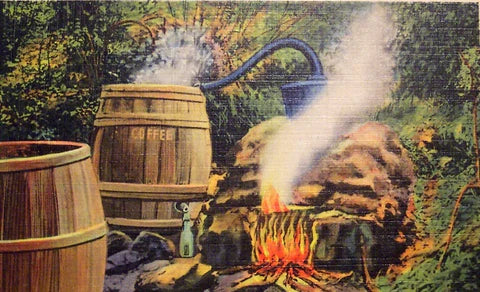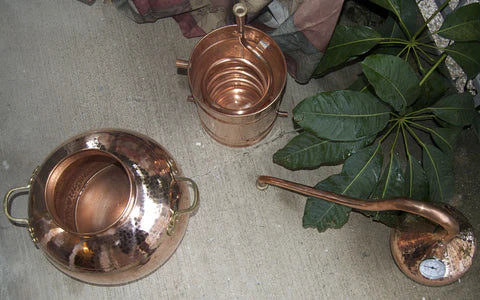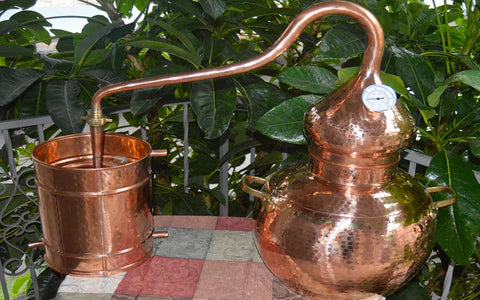 There's always a right way, and a wrong way, to go about distilling at home
There's always a right way, and a wrong way, to go about distilling at home
"Making Moonshine in Kentucky"
Moonshiners know that there will always be some safety hazards when working with a heat source, hot metal, and flammable vapors - and distilling includes all of those dangers. Before you mix up the mash for your first run, before you turn on the heat, stop and prepare yourself to avoid a serious consequence you could later regret.
Here are our top 7 Tips for Safe Distilling:
1. Know the Law
While federal law states that it is legal for anyone to own a still of any size for decorative purposes, or to distill water or essential oils legally, people who want to distill alcohol at home need to apply for the proper license. Federal licenses include a Federal Distilled Spirits Permit , which allows distillers to produce consumable (drinkable) alcohol, as well as the Federal Fuel Alcohol Permit, which allows distillers to produce non-consumable alcohol to be used as ethanol fuel.
In addition to these federal laws and licenses, there may be state, county, city, or other local measures that someone who distills alcohol at home may need to take in order to be in compliance with the law. We always recommend you purchase and use one of our copper whiskey stills for sale responsibly.
2. Distill Outside
When the grain mash is heated in the pot still, the steam includes not only water vapor, but alcohol vapor as well. Although you should seal any leaks in your still to prevent a build-up of alcohol vapor leaking from any joints, there will still be flammable vapors that may escape the condenser coil.
The bottom line is: for safety’s sake, always distill in a well-ventilated area. Outdoors is generally preferred.
3. Control Your Temperature
Copper whiskey stills distribute heat very efficiently, and if not properly monitored, a distiller can suffer serious burns as well as ruin the moonshine in the run. Use a controllable heat supply, so that you can increase or decrease it whenever you need. Get a thermometer to always monitor the temperature in the onion head, or better yet, choose a moonshine still design with a built-in thermometer. Lastly, always make sure that you have a controlled method to keep the temperature of your condenser coil cooled, so that you will not risk ruining your distilling efforts.
4. Have a Fire Extinguisher
Because of the flammable vapors and the possibility of a fire starting, you should always have a fire extinguisher within arm’s reach any time you are distilling alcohol.
5. Heat Protective Gear (and NO plastic!)
You may feel like a bit of a chemistry or science nerd, but it can be well worth it to invest in some high-temperature insulated gloves and some heat-protective eye gear. When handling a still during a run, it is easy to get burned. Many people forget how hot steam is, and how serious steam burns can be.
The vapors that are released when distilling certain essential oils may also be damaging to soft eye tissues as well, and eye protection can be especially important when dealing with botanicals.
6. No Drinking or Horseplay
Of course it’s tempting. You wouldn’t be distilling your own alcohol if you weren’t a fan of alcohol in general. But, you should never, never drink while operating a whiskey or moonshine still, and you should not let others who have been drinking come in near an operating still.
Likewise, remember all the signs at the pool when you were a kid? Adopt the same rules when you distill. Don’t allow anyone to endanger injuring themselves. No running, jumping, messing around with the tools, or otherwise playing that could get someone hurt.
7. Make Knowledgeable Cuts
Making moonshine is both an art and a science. As the run progresses, an experienced distiller begins to learn when to “cut” the run - when to switch the containers collecting the distillate. The first cut is after the “foreshots” are completed. Foreshots go straight into the trash. Foreshots generally make up about the first 5% or so of the run, and the first cut to the run is typically made after the onion bulb temperature reaches 174 degrees.
The foreshots are trash because they are high in methanol. Methanol is poisonous and should not be included in your final product. It burns off from your alcohol mash and makes its way to the collection cup at lower temperatures than other alcohols. Know when to cut your run, including the foreshots, and always throw them out.
Follow these 7 tips to ensure that every time you’re using your best copper moonshine still, you are doing it safely. Never put yourself or another person in danger. Following these and other simple basic safety rules will keep you enjoying your copper whiskey still for years to come.
Article by: Jim Thomas



